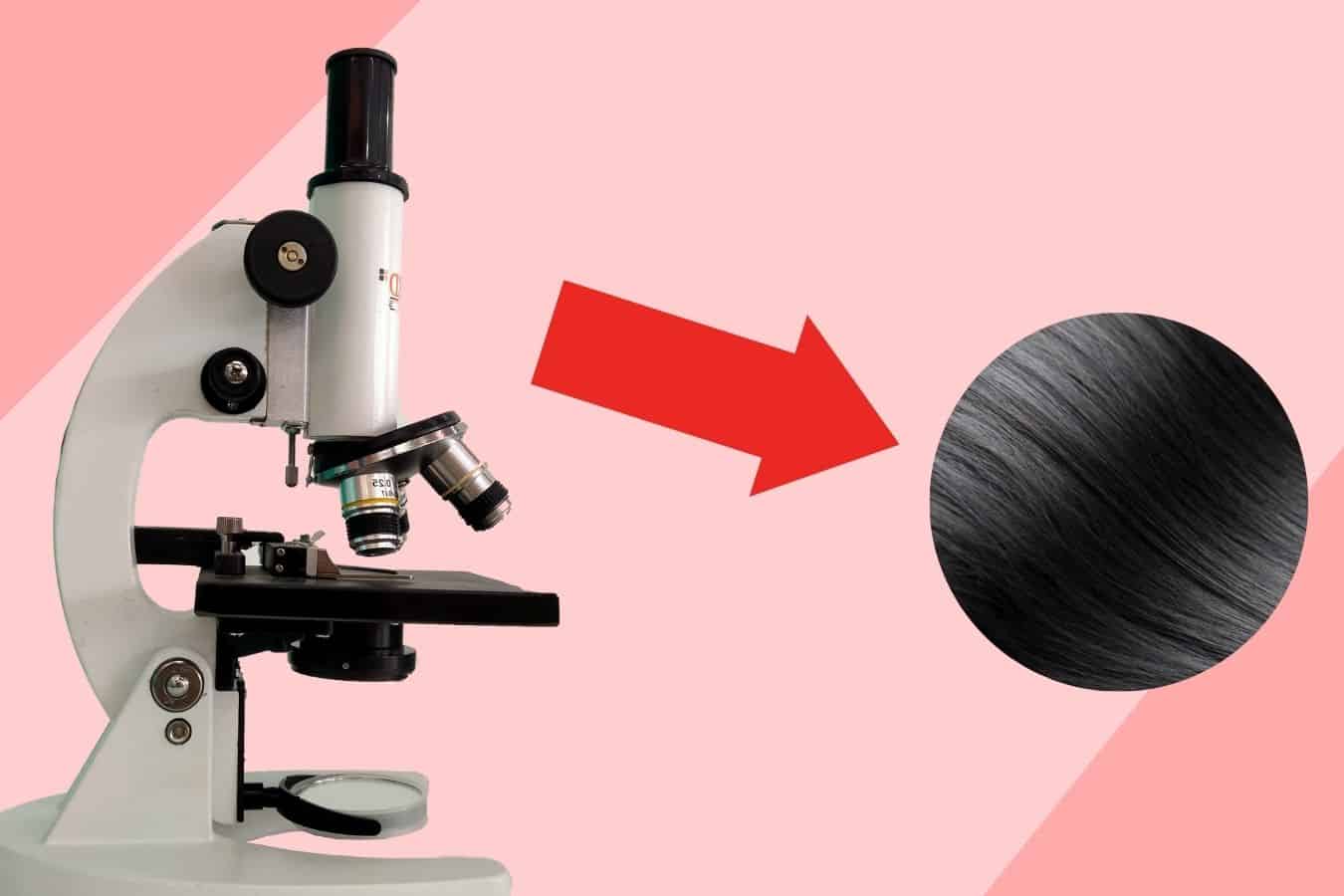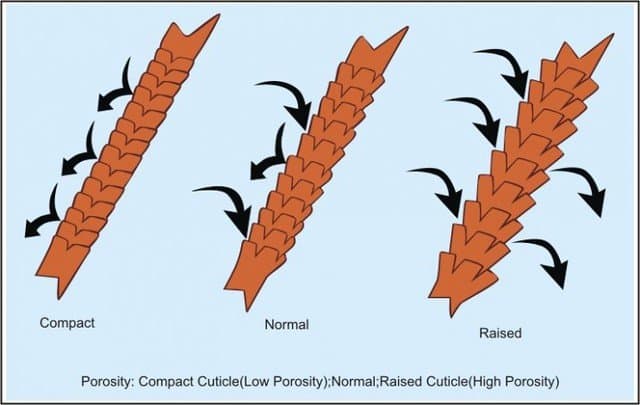You can figure out your hair type by doing a simple test, and there are even some places that now offer microscopic hair analysis. But can a microscope determine the porosity of hair?

In short yes, a microscope can determine the porosity of hair. This is because a microscope has the ability to inspect the cuticle’s condition and see how much of this outer layer has chipped or worn away.
Let’s take a look at hair porosity in further detail.
This post contains affiliate links and we may earn if you click on them (at no extra cost to you). Please read our full disclosure policy here.
What Is Hair Porosity?
Each strand of hair on your head can absorb and retain moisture, and your porosity can determine what hair products you should use in your hair care routine to keep your hair in the best condition possible.
Hair porosity is split into three categories; low porosity, medium porosity, and high porosity.
To fully understand what hair porosity means, you need to know about the structure of your hair:
Every hair on your head has three layers: the cuticle, the cortex, and the medulla.
- The cuticle is the protective outer layer of your hair and is tough. It is made up of smaller cuticles that overlap one another.
- The cortex is the middle layer of the hair shaft, and it contains fibrous proteins and pigment, which provides strength and color to the hair.
- The medulla is the central layer of the hair shaft and is the softest, most fragile part of the hair.
Water, oils, and moisture need to reach the cortex by passing through the cuticle for your hair to stay healthy and hydrated.
If the cuticles are too close together or too far apart, it can cause issues.

When the cuticles are too close together, water and oils cannot penetrate the hair easily. This makes it hard for your hair to get the required moisture it needs to stay healthy.
If the cuticles are too wide apart, it can make it difficult for your hair to absorb and retain any moisture.
What Are The Different Types Of Hair Porosity?
We’ve mentioned that there are three categories of hair porosity, low, medium, and high. But what does each one mean, and how does it affect your hair?
Low Porosity
Low porosity is when the cuticles are very close together and tend to overlap each other.
This prevents water, oils, and conditioners from reaching the hair shaft to deliver moisture. Characteristics of low porosity hair include:
- Products sit on your hair instead of absorbing.
- Water is not easily absorbed by the hair and can take longer to wash.
- Hair can also take longer to air dry or blow-dry.
Also Read: Does Low Porosity Hair Need Protein? (How To Tell)
Medium Porosity
Medium porosity is when the cuticles are not as tightly together and not too far apart. This means that enough moisture reaches the shaft to leave your hair looking and feeling in good condition.
Not much maintenance is required if you have medium porosity hair. Characteristics of medium porosity hair include:
- Products generally work, and hair is easy to style.
- Hair looks healthy and has a shine to it.
- Hair does not take too long to air dry.
High Porosity
High porosity is when the cuticles are further apart. If you have high porosity hair, it will absorb moisture or water, but your hair will be unable to hold onto it for long.
This can leave your hair looking and feeling dry, as there won’t be any moisture to keep it hydrated.
Characteristics of high porosity hair include:
- Water, oils, and conditioners absorb into the hair quickly.
- Hair is frizzy, dry, and breaks easily.
- Hair air dries very quickly.
What Causes High Or Low Porosity In Hair?

The high or low levels of porosity in the hair are determined by several factors such as genetics, hair treatments, and ultraviolet exposure:
Genetics
Genetics can play a role in whether you will have high or low hair porosity. If your family mostly has high porosity hair, it’s very likely you will have high porosity hair too.
Hair Treatments
Many hair treatments can cause damage to your hair. If you blowdry, straighten, bleach, or even overwash your hair, then your hair cuticles can open over time.
This can make it difficult for your hair to retain any moisture.
Ultraviolet Exposure
If your hair is exposed to ultraviolet often, it can increase your hair porosity.
This is why it’s recommended to wear a hat or head covering when you are outside to help protect your hair from the sun.
How Porous Is Your Hair?
Based on the characteristics that we mentioned for each porosity category, you may have some idea as to how porous your hair is.
If you are unsure whether your hair is low or high porosity, there are ways you can find out.
A simple way to discover how porous your hair is is by doing the float test, which can be easily done at home.
Another option is to have your hair analyzed to see can a microscope determine the porosity of hair.
The Float Test
1. Wash your hair using shampoo to remove any product build-up.
2. Get a glass of water and drop a single strand of hair into the glass.
3. Check if the hair floats on top of the water or sinks to the bottom of the glass.
If the hair sinks to the bottom right away, you have high porosity hair. If it falls to the bottom slowly, you have medium porosity hair, and if it floats on top, you have low porosity hair.
Is The Float Test Reliable?
Although the float test can indicate how porous your hair really is, there are some variables you need to consider when doing this test.
First, you need to consider any product on the hair that may make it heavier. If the product repels water or is a conditioner, it can make the hair wetter more quickly and cause the hair to sink to the bottom of the glass.
You also need to consider the water’s surface tension. When the molecules at the surface of the water meet the air, they tend to stick together.
So if you place the strand of hair in the glass, the surface tension could quash the hair strand’s porosity, causing it to float regardless of whether the hair is high porosity.
Also Read: The LOC Vs LCO Method: Which Is Right For You?
Can A Microscope Determine Porosity Of Hair?

Microscopes can be used to observe and study hair strand characteristics to determine a number of things, such as pigmentation and the hair’s structure.
So for a more accurate way of determining hair porosity, you can examine the strand of hair under a microscope.
This will allow you to see how much damage has been done to the cuticle. The microscope will show whether the cuticle is chipped, worn away, cracked, shrunken, or fused.
Other Easy Ways Of Testing Hair Porosity Besides A Microscope
Besides the float test and using a microscope to analyze hair strands to determine hair porosity, you can also use these other easy methods.
Spritz Water Onto Hair And Time How Long It Takes To Dry
When your hair is dry, simply spritz some water onto it. You will need to note how long it takes your hair to absorb the moisture.
Your hair is likely to be low porosity if the water sits on top of your hair strands for a while. If your hair soaks up the water straight away, you likely have high porosity hair.
Run Your Fingers Over A Strand Of Hair
Another easy way to determine if you have low or high porosity hair is to run your fingers down a strand of hair.
If you have low porosity hair, your hair will feel smooth. If you have high porosity hair, it will feel bumpy and rough in texture because the cuticles are open and further apart.
How To Care For Different Types Of Hair Porosity
Whether you have low, medium, or high porosity hair, there are products you can use as part of your hair care routine to leave your hair looking and feeling healthy, more manageable, and easy to style.
Low Porosity Hair
If you have low porosity hair, you need to focus more on moisture than protein. You should choose a shampoo that won’t leave too much residue.
Shampoos that include honey or glycerin as ingredients will penetrate the cuticle easily.
Garnier Ultimate Blends Honey Strengthening Shampoo is excellent for dry and damaged hair.
It contains honey, which you need to penetrate the cuticle, leaving your hair nourished and stronger.
Also Read: Hydrolyzed Wheat Protein: The Secret To Amazing Hair?
Medium Porosity Hair
For those with medium porosity hair, you need to maintain the balance of moisture and protein. This means you need to alternate products each week to ensure the balance is maintained.
For example, one week you should do a deep conditioning treatment on your hair after shampooing, then the following week, do a protein treatment after shampooing.
The Garnier Ultimate Blends Hair Food Banana 3-in-1 Nourishing Hair Mask will instantly absorb into your hair without weighing it down, leaving it looking healthy and shiny.
High Porosity Hair
If you have high porosity hair, you will need to focus on both moisture and protein.
Consider using shampoos and conditioners that contain butters and oils, as this will help your hair maintain moisture.
Use leave-in conditioners to help your hair hold onto any moisture, and before you blow-dry your hair, use a heat protectant product like L’Oreal Elnett Heat Protect Styling Hairspray to avoid heat damage to your hair.

Disclaimer: This site is not intended to provide professional or medical advice. All of the content on LovedByCurls.com is for informational purposes only. All advice should be followed at your own discretion. Ingredients may change at any time so always check the product label before using. Check our full disclaimer policy here.
